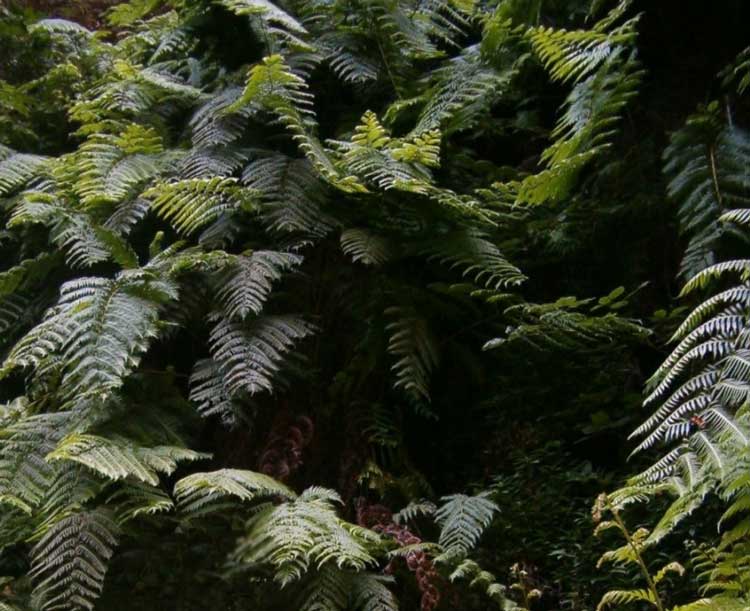
Woodwardia radicans
Superregnum: Eukaryota
Regnum: Plantae
Divisio: Tracheophyta
Divisio: Pteridophyta
Classis: Polypodiopsida
Ordo: Polypodiales
Familia: Blechnaceae
Subfamilia: Woodwardioideae
Genus: Woodwardia
Species: Woodwardia radicans
Name
Woodwardia radicans (L.) Sm., Mém. Acad. Turin 5: 412. 1793.
Synonyms
Basionym
Blechnum radicans L., Mant. Pl. Altera 307. 1771, [Oct 1771].
Type locality: “"Habitat in Virginiae er Maderae rimis rupium profundis argillaceis. König."”
Lectotypus (designated by Reveal in C. Jarvis, Order out of Chaos: 353. 2007.): König s.n., Herb. Linn. No. 1247.4 (LINN).
Heterotypic
Blechnum houttuynii Poir., Encycl. suppl. 1: 644. 1810.
Woodwardia stans Cav., Hort. Reg. Matrit.: 45 (facs.), Tab. 82 (original unpublished) ex Sw., Syn. Fil. 117. 1806.
Blechnum stans (Cav.) Poir., Encycl. suppl. 1: 644. 1810.
Distribution
Native distribution areas:
Continental: Europe
Regional: Southwestern Europe
Corse, Portugal, Spain
Regional: Southeastern Europe
Italy, Kriti, Sicilia (Sicily).
Continental: Africa
Regional: Northern Africa
Algeria.
Regional: Macaronesia
Azores (Corvo, Faial, Flores, Pico, Santa Maria, Sao Jorge, Sao Miguel, Terceira), Canary Islands (Gran Canaria, Gomera, Hierro, La Palma, Tenerife), Madeira (Madeira).
Continental: Northern America
Regional: Southwestern U.S.A.
California (introduced)
Regional: Southeastern U.S.A.
Florida (introduced).
References: Brummitt, R.K. 2001. TDWG – World Geographical Scheme for Recording Plant Distributions, 2nd Edition
References
Primary references
Smith, J.E. 1793. Tentamen botanicum. De filicum generibus dorsiferarum. Mémoires de l'Académie Royale des Sciences 5: 401–422, pl. IX. BHL Reference page.
Linnaeus, C. 1771. Mantissa Plantarum Altera. Generum Editionis VI et Specierum Editionis II. Holmiae [Stockholm]. pp. [6] + 143–587, Appendix. BHL Reference page.
Additional references
Jarvis, C.E. 2007. Order out of Chaos: Linnaean Plant Names and their Types. London: Linnean Society of London in association with the Natural History Museum, ISBN 978-0-9506207-7-0, p. 353. Reference page.
Links
Hassler, M. & Schmitt, B. 2019. World Ferns. Checklist of the Ferns and Lycophytes of the World. Version 7.71 – March 2019. Accessed 7 May 2019.
Hassler, M. 2019. Woodwardia radicans – World Ferns: Checklist of Ferns and Lycophytes of the World . In: Roskov Y., Orrell T., Nicolson D., Bailly N., Kirk P.M., Bourgoin T., DeWalt R.E., Decock W., De Wever A., Nieukerken E. van, Zarucchi J. & Penev L. (eds.) 2019. Species 2000 & ITIS Catalogue of Life. Published on the internet. Accessed: 2019 May 07.
International Plant Names Index. 2019. Woodwardia radicans. Published online. Accessed: May 07 2019.
The Plant List 2013. Woodwardia radicans in The Plant List Version 1.1. Published online. Accessed: 2019 May 07.
Govaerts, R. et al. 2019. Woodwardia radicans in Kew Science Plants of the World online. The Board of Trustees of the Royal Botanic Gardens, Kew. Published online. Accessed: 2019 May 07. Reference page.
Tropicos.org 2019. Woodwardia radicans. Missouri Botanical Garden. Published online. Accessed: 07 May 2019.
USDA, ARS, Germplasm Resources Information Network. Woodwardia radicans in the Germplasm Resources Information Network (GRIN), U.S. Department of Agriculture Agricultural Research Service. Accessed: 08-Apr-12.
Vernacular names
corsu: Filetta sischese
Deutsch: Wurzelnder Kettenfarn
English: Rooting chainfern
español: Píjara
italiano: Felce bulbifera
português: Feto-de-botão
Woodwardia radicans, the chain fern,[3] European chain fern or rooting chainfern, is a species of fern in the family Blechnaceae, mainly found in Macaronesia and southwestern Europe, but is also found in southern Italy and Crete. Growing to 1.8 m (6 ft) tall by 2 m (7 ft) broad, it is evergreen with arching fronds. The pinnae have curved, finely-toothed segments. The plant derives its common name from the linked sori on the undersides of the fronds.[4][5]
The specific epithet radicans means "with stems that take root", referring to rooting plantlets appearing at the tips of the fronds.[6]
This plant is cultivated as an ornamental, and in the UK has gained the Royal Horticultural Society's Award of Garden Merit.[7][8] Unlike its hardier cousin Woodwardia unigemmata, it is prone to frost damage and requires protection in colder areas.[9]
Woodwardia radicans (Leaf).jpg
References
Christenhusz, M., Bento Elias, R., Dyer, R., Ivanenko, Y., Rouhan, G., Rumsey, F. & Väre, H. (2017). "Woodwardia radicans". IUCN Red List of Threatened Species. 2017: e.T162393A85426487. Retrieved 8 December 2020.
"International Plant Names Index (IPNI) - Woodwardia radicans". Retrieved 15 May 2013.
BSBI List 2007 (xls). Botanical Society of Britain and Ireland. Archived from the original (xls) on 2015-06-26. Retrieved 2014-10-17.
RHS A-Z encyclopedia of garden plants. United Kingdom: Dorling Kindersley. 2008. p. 1136. ISBN 1405332964.
"Plants for a future (PFAF) - Woodwardia radicans". Retrieved 15 May 2013.
Harrison, Lorraine (2012). RHS Latin for gardeners. United Kingdom: Mitchell Beazley. p. 224. ISBN 9781845337315.
"Woodwardia radicans". Royal Horticultural Society. Retrieved 17 March 2021.
"AGM Plants - Ornamental" (PDF). Royal Horticultural Society. July 2017. p. 108. Retrieved 10 March 2019.
"Woodwardia unigemmata". Architectural Plants. Retrieved 10 March 2019.
Retrieved from "http://en.wikipedia.org/"
All text is available under the terms of the GNU Free Documentation License

